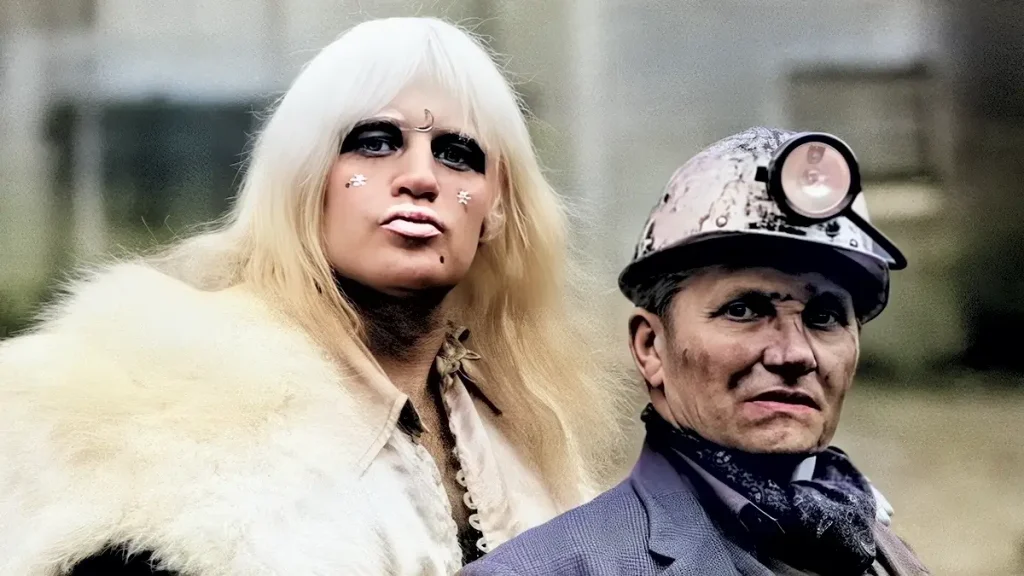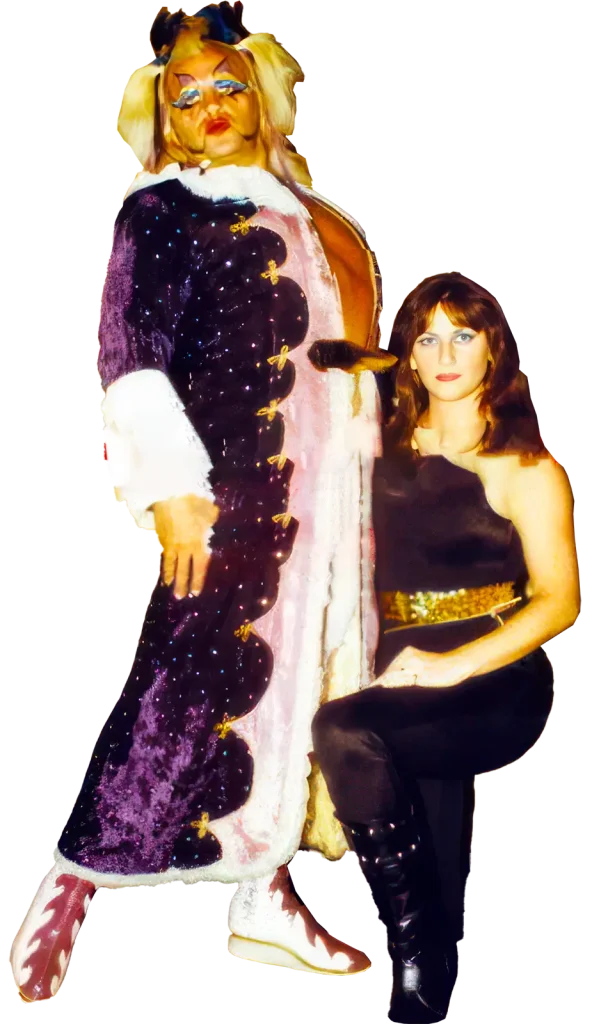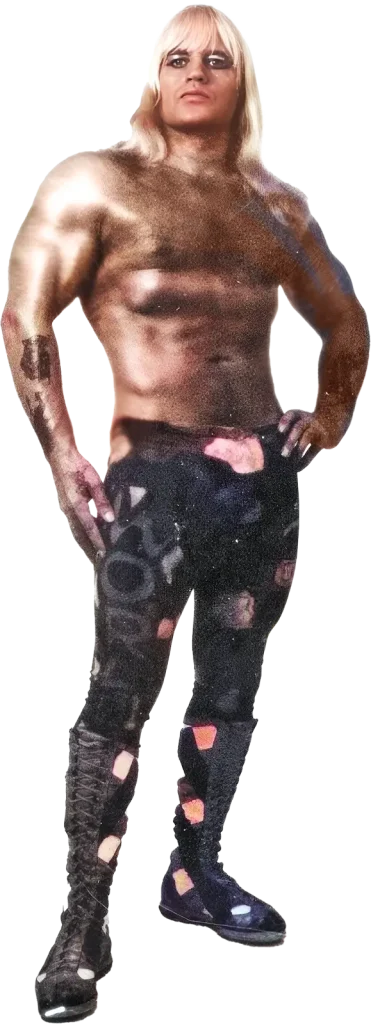The tale of “Exotic” Adrian Street is a captivating one for any true wrestling fan, even though his name might be unfamiliar to the casual fan. Despite his smaller size in the world of professional wrestling, his flamboyant, effeminate character, complete with savage tendencies, never failed to elicit a strong reaction from the crowd. By creating this highly provocative, controversial persona as early as the mid-1960s, Street broke the boundaries of professional wrestling. At a time when U.S. and European societies were particularly conservative, his cross-dressing, hyper-sexualized character, accompanied by Miss Linda, pushed every envelope possible to create controversy and stand out in the industry.
Real Name: Adrian Street
Stats: 5′ 7″ 235 lbs.
Born: December 20, 1940
Early Life
A flamboyant and controversial figure in the world of professional wrestling, Street was born on December 5, 1940, to a coal miner in Blaenau Gwent, Wales. Growing up in a place with few opportunities for fun, he was already working in the mines at fifteen years old. The young Street wanted nothing to do with his father’s contemptuous behavior or the elder Street’s miserable existence. At the age of sixteen, he left behind his troubled home life to pursue his dream of becoming a professional wrestler. Moving to London with few possessions, the 5’7″, 150 lb. teenager worked out at a local YMCA and learned the art of submission wrestling by grappling with experienced matmen at Johnny Kilroy’s Gym. His first big break came when I was introduced to promoter Ted Beresford, who took me under his wing and helped him to get his first matches.
Although he was smaller in stature compared to other professional wrestlers, Street’s effeminate, kiss-blowing, prissy, and incredibly savage pseudo-transgender character never failed to garner a significant reaction from his audience. By developing this highly risqué, controversial persona in the mid-1960s, the cross-dressing, highly sexualized character that Street created genuinely pushed the limits of professional wrestling. Well before “Adorable” Adrian Adonis and Goldust & Marlena, there was “Exotic” Adrian Street & Miss Linda, blowing kisses to his most masculine ringside detractors, sporting makeup and women’s clothing, and striving to push every hot button he could to differentiate himself and create controversy, all during one of the most conservative periods in modern US and European history.
Career
Street made his professional wrestling debut in 1957, wrestling under the name Kid Tarzan Jonathan and billing himself as “The World’s Youngest Wrestler.” He gradually developed a reputation throughout the tough British independent wrestling circuit while gaining much-needed experience as a professional wrestler. At the time of his debut in 1957, professional wrestling in Britain, while still a relatively underground form of entertainment, was thriving, and it was not uncommon for dozens of wrestling shows to take place throughout the country in bars, hotels, and small arenas on any given night. However, unlike their American counterparts, British wrestlers were notoriously understated in both their appearance and demeanor and, for the most part, lacked the individuality or flamboyance associated with professional wrestlers. The young Kid Tarzan decided to combine the best of both worlds and focused on creating a character that could wrestle with the best of Britain’s no-nonsense technical masters while being as charismatic and entertaining as Gorgeous George, “Mr. America” Gene Stanlee, Ricky Starr, Buddy Rogers, or other flamboyant American stars that he admired from afar.
After a few years on the independent scene, Kid Tarzan Jonathan’s unique look and style garnered attention, and he soon found himself wrestling in countries across Europe, including France, Germany, and Spain. He began using his birth name and transformed himself from an athletic and young, albeit somewhat ordinary, wrestler into something rather distinct. Initially, Street displayed his individuality through a platinum blonde hairdo and a colorful wardrobe reminiscent of his idol Buddy Rogers, which was enough to set him apart from his drab countrymen. Known as “Nature Boy” Adrian Street, he provoked such a negative response from conservative, working-class English audiences that it became increasingly clear which way the former Kid Tarzan should take his new persona. To Street, it was evident that the more he pushed the boundaries, the more the crowd reacted. Inspired by the glam rock scene in the United Kingdom, he would wear outrageous costumes and glittery makeup and even carry a mirror to the ring. People hadn’t seen anything like it before in wrestling, which certainly got people talking. By acting as feminine, prissy, and snobbish as he could but then backing it up with solid technical wrestling mixed with plenty of “illegal” tactics, Street received unprecedented crowd responses and was soon the talk of the European wrestling scene.
During the 1960s and 1970s, Adrian Street continued to push boundaries and win championships, solidifying his flamboyant look and captivating audiences. Professional wrestling was still a male-dominated sport, and Adrian’s flamboyant persona didn’t always sit well with his peers. He faced much backlash from other wrestlers, but I never let it get to him, he was determined to stand out and make a name for himself.
He won the European Tag Team title with “Beautiful” Bobby Barnes, as well as the European Middleweight, European Light Heavyweight, the British Welterweight Championship, and European Heavyweight titles on multiple occasions. In 1969, he also introduced his valet, the beautiful and dangerous Miss Linda, unprecedented in England and America at the time. After over two decades of climbing the ranks in the European wrestling scene, he left his coal mining days behind.
Street went to North America in 1981, almost 25 years after his wrestling debut. He had a brief stint in Canada before heading to Mexico, where he and Miss Linda had a successful feud with Mil Mascaras and Dos Caros. They eventually arrived in the Los Angeles territory under LaBell, where Street again stirred up controversy and won the Americas Heavyweight and Tag Team championships.
In the mid-1980s, Street formed the Skull Krusherz tag team with his partner, “The Monster” Rip Rogers. The duo terrorized opponents with their ruthless in-ring tactics and flashy attire. The Skull Krusherz captured the Continental Wrestling Federation’s Tag Team Championship, further cementing Street’s legacy as one of wrestling’s most accomplished performers.
After Tennessee, Adrian Street and Miss Linda joined Eddie Graham’s Florida-based promotion, one of the top territories of the NWA. There, Street pushed his effeminate character to the limit, winning championships and riling up the fans with his pseudo-homosexual gimmick. He clashed with the area’s popular tough guys, including “The American Dream” Dusty Rhodes, and engaged in a lengthy feud with Stardust, even cutting Rhodes’ hair in a controversial bout.

Adrian Street and his Father.
Encouraged by the negative response from Florida crowds, Street set his sights on Texas. He brought his extensive collection of gowns, robes, and makeup, along with his obedient “slave” Miss Linda, to the Lone Star State. The macho cowboy audiences were unlike any he had encountered before, and his antics such as smacking his opponents on the behind and kissing them on the mouth, incited a hostile relationship between Street and the conservative southwestern crowds. However, their mutual disdain resulted in big and memorable shows wherever The Exotic One appeared.
Overall, Adrian Street’s character was a groundbreaking departure from the traditional look and mannerisms of professional wrestlers, and his ability to incite strong reactions from crowds made him a successful and memorable performer in multiple territories across the United States. Street’s famous finishing move, the “Cobra Clutch,” became a staple in professional wrestling and is still utilized by performers today.
Rivalries
Adrian Street engaged in a long and violent feud with “Macho Man” Randy Savage during the mid-Eighties, just prior to Savage’s debut with the World Wrestling Federation. Savage and Street battled throughout the Memphis-based CWA, with Miss Linda often involved in the heated rivalry. At one point, Savage even tried to deliver a Piledriver to Street’s alluring valet. Street gave up a great deal of size to The Macho Man, but he was more than used to overcoming such hurdles. Savage was on the receiving end of a great deal of punishment from the 210 lb. Street during their classic battles. After his run with Savage, “Exotic” Adrian engaged in another memorable feud with the equally flamboyant “Universal Heart Throb” Austin Idol. Idol, and Street had many bloody battles during this period, and their feud was one of the hottest on the Gulf Coast circuit.
While wrestling in the Pensacola territory, Street won the prestigious Southeastern Heavyweight title not once, but four times. True to form, The Exotic One eventually had his Southeastern championship belt refitted with a custom pink leather strap. In 1986, Street signed a recording contract with Rhino Records and released the album “Shake, Wrestle and Roll.” Backed by his band, The Piledrivers, he had previously released two singles, which were included on the record, along with new material. Adrian Street also appeared in several notable films, including the award-winning Quest for Fire, Rewind, and The Canterbury Tales. He was featured prominently (along with Roddy Piper, Lou Albano, and a slew of 1980s ring performers) in Grunt: The Wrestling Movie.
Adrian Street continued his success in major wrestling promotions such as Jim Crockett’s NWA Mid Atlantic and Bill Watts’ Mid-South (later UWF), winning the Mid-South TV title in 1984. Despite his outrageous gimmick, he never competed in the WWF, possibly due to his smaller stature. However, Vince McMahon eventually created a similar character in “Adorable” Adrian Adonis during the mid-1980s, and later with Goldust and Chuck and Billy in the mid-1990s. Street’s innovative character had paved the way for many of the features we see in professional wrestling today, including face paint, spandex, and valets.
In the early 1990s, Street began to wind down his career and explore new business opportunities. He and Linda started designing ring gear and fashion with his company “Exotic Adrian Street’s Bizarre Bazaar.” This venture allowed him to combine his artistic talent with his passion for wrestling, providing unique and eye-catching outfits for wrestlers around the world. He and Linda opened a website called Bizarre Bazaar and he also opened his own wrestling training facility, the Skull Krushers Wrestling School in Florida. However, the academy was forced to close due to hurricane damage in 2004.
Adrian Street’s personal life has been marked by a long-lasting and supportive marriage to his wife, Linda. The couple had been together for over three decades, with Linda having played a significant role in Street’s wrestling career as his valet and manager (although many assumed that they were married over the years, Street actually proposed to Linda at the 2005 Cauliflower Alley Club reunion). Their strong bond and commitment to each other have been key factors in their successful marriage, providing stability and love in both their personal and professional lives.

Awards & Titles
Throughout his career, Street received several awards for his unique gimmick and contribution to wrestling, including the Wrestling Observer Newsletter’s Best Gimmick Award in 1986 and the Cauliflower Alley Club’s Gulf Coast/CAC Honoree Award in 2005. After a career spanning more than fifty years, he retired from wrestling in 2010 and overcame throat cancer. Street now resides in his native Wales.
Legacy
As the “Exotic” Adrian Street, he shattered stereotypes by adopting a highly effeminate and flamboyant character, wearing makeup, glitter, and outlandish outfits. Street’s gimmick was groundbreaking, as it directly challenged the traditional, hyper-masculine image of wrestlers during his time. He has been featured in various documentaries, including the acclaimed “You May Be Pretty, But I Am Beautiful: The Adrian Street Story,” which chronicles his life and career.
His enduring legacy is a testament to his trailblazing spirit and willingness to push boundaries. His innovative persona, contributions to the wrestling industry, and lasting cultural impact have shaped the sport in countless ways. As new generations of wrestlers and fans continue to discover his work, Adrian Street’s influence will undoubtedly continue to inspire and resonate within the wrestling world and beyond.
Frequently Asked Questions
Adrian Street, known by his ring name “Exotic” Adrian Street, is a legendary professional wrestler from Wales, renowned for his provocative, effeminate character that broke barriers in the industry during the conservative mid-1960s. With Miss Linda by his side, his highly controversial persona was designed to provoke strong reactions and push boundaries, making him a standout figure in the wrestling world.
Born on December 5, 1940, in Blaenau Gwent, Wales, to a coal miner, Street started working in the mines at the age of fifteen. Unwilling to settle for a life in the mines, he moved to London at sixteen, pursuing his dream of becoming a wrestler. Training at the YMCA and Johnny Kilroy’s Gym, he eventually broke into the professional wrestling scene under the guidance of promoter Ted Beresford.
In a conservative era, Street’s character was effeminate, kiss-blowing, and dressed in women’s clothing, complete with makeup. This character, accompanied by his valet, Miss Linda, created a huge stir and controversy, drawing unprecedented crowd responses.
Street secured various titles, including the European Tag Team, European Middleweight, European Light Heavyweight, British Welterweight Championship, and European Heavyweight titles. In America, he also captured the Americas Heavyweight and Americas Tag Team championships, among others.
Throughout his career, Street had intense rivalries with wrestling greats like “Macho Man” Randy Savage and the “Universal Heart Throb” Austin Idol. He also had notable confrontations with “The American Dream” Dusty Rhodes and Stardust.
Street’s effeminate, flamboyant character was groundbreaking, challenging the traditionally hyper-masculine image of wrestlers of his time. His persona paved the way for features in professional wrestling like face paint, spandex, and valets. Street’s gimmick influenced future characters, with promotions like WWF creating similar personas in later years.
Yes, Street delved into music, signing a contract with Rhino Records, releasing an album, and even acting in several films. He also established “Exotic Adrian Street’s Bizarre Bazaar”, designing unique wrestling outfits, and opened the Skull Krushers Wrestling School.
Adrian Street’s willingness to break stereotypes and introduce a groundbreaking, effeminate character has left an indelible mark on professional wrestling. His persona, influence, and contributions continue to inspire new generations of wrestlers and fans.


